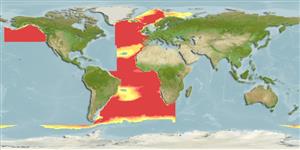Common names from other countries
>
Beryciformes (Sawbellies) >
Melamphaidae (Bigscale fishes or ridgeheads)
Etymology: Poromitra: Greek, poros = porous + Greek, mitra = stripe, belt (Ref. 45335); crassiceps: Named crassiceps for its thick head (Ref. 6885).
More on author: Günther.
Issue
Distribution needs to be defined; previous reports may refer to other species of Poromitra (Ref. 83717, 83719).
Environment: milieu / climate zone / depth range / distribution range
Ecologia
marinhas batipelágico; intervalo de profundidade 164 - 2730 m (Ref. 83717), usually 750 - 2730 m (Ref. 83717). Deep-water
Distribution needs to be defined. Formerly assigned as senior synonym of eight nominal species: P. atlantica, P. coronata, P. cristiceps, P. frontosa, P. nigriceps, P. nigrofulva, P. rugosa, P. unicornis (Ref. 83717).
Length at first maturity / Tamanho / Peso / Idade
Maturity: Lm 12.3, range 9 - 15.6 cm
Max length : 14.8 cm SL macho/indeterminado; (Ref. 54657); Idade máx. registada: 9 anos (Ref. 54657)
Descrição breve
Chaves de identificação | Morfologia | Morfometria
Espinhos dorsais (total) : 3; Raios dorsais moles (total) : 12 - 13; Espinhos anais: 1; Raios anais moles: 9 - 10; Vértebras: 27 - 29. This species is distinguished by the following characters: spinulated (without gap) posterior and lower edges of praeoperculum; insertion of ventral fins behind the vertical of posterior edge of pectoral fin insertion; upper jaw extends beyond the vertical of posterior eye edge; soft rays in dorsal fin 12-13, in anal fin 9-10; rakers at first gill arch 28-30; vertebrae 27-29; pyloric caeca 6 (Ref. 83717).
Oviparous, with planktonic eggs and larvae (Ref. 36655). There is significant morphological variation between populations (Ref. 4241).
Life cycle and mating behavior
Maturities | Reprodução | Spawnings | Egg(s) | Fecundities | Larvas
Kotlyar, A.N., 2008. Revision of the genus Poromitra (Melamphaidae): Part 1. Species of group P. crassiceps. J. Ichthyol. 48(7):479-492. (Ref. 83717)
Categoria na Lista Vermelha da IUCN (Ref. 130435)
CITES (Ref. 128078)
Not Evaluated
Ameaça para o homem
Harmless
Utilização humana
Pescarias: sem interesse
Ferramentas
Relatórios especiais
Descarregue XML
Fontes da internet
Estimates based on models
Preferred temperature (Ref.
115969): 1.7 - 6.3, mean 3.2 (based on 2535 cells).
Phylogenetic diversity index (Ref.
82804): PD
50 = 0.5000 [Uniqueness, from 0.5 = low to 2.0 = high].
Bayesian length-weight: a=0.00912 (0.00403 - 0.02064), b=3.09 (2.89 - 3.29), in cm Total Length, based on LWR estimates for this species & (Sub)family-body (Ref.
93245).
Nível Trófico (Ref.
69278): 3.1 ±0.30 se; based on food items.
Resiliência (Ref.
120179): Médio, tempo mínimo de duplicação da população 1,4 - 4,4 anos (tmax=8.5).
Fishing Vulnerability (Ref.
59153): High vulnerability (56 of 100).
